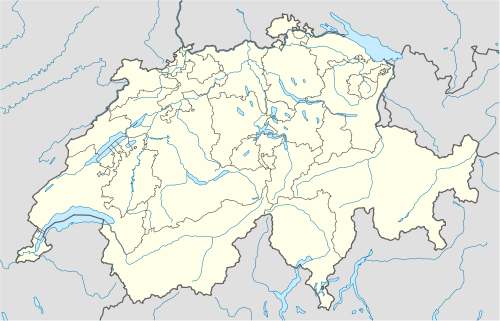Kyburg, Zurich
| Kyburg | ||
|---|---|---|
 | ||
| ||
 Kyburg | ||
|
Location of Kyburg  | ||
| Coordinates: 47°27′N 8°45′E / 47.450°N 8.750°ECoordinates: 47°27′N 8°45′E / 47.450°N 8.750°E | ||
| Country | Switzerland | |
| Canton | Zurich | |
| District | Pfäffikon | |
| Area[1] | ||
| • Total | 7.63 km2 (2.95 sq mi) | |
| Elevation | 640 m (2,100 ft) | |
| Population (Dec 2013[2]) | ||
| • Total | 407 | |
| • Density | 53/km2 (140/sq mi) | |
| Postal code | 8314 | |
| SFOS number | 0175 | |
| Surrounded by | Illnau-Effretikon, Weisslingen, Winterthur, Zell | |
| Website |
www SFSO statistics | |
Kyburg is a municipality in the district of Pfäffikon in the canton of Zürich in Switzerland.
History
Kyburg is first mentioned in 1027 as Chuigeburch.[3]
Geography

Kyburg has an area of 7.6 km2 (2.9 sq mi). Of this area, 31.9% is used for agricultural purposes, while 61% is forested. Of the rest of the land, 5.4% is settled (buildings or roads) and the remainder (1.7%) is non-productive (rivers, glaciers or mountains).[4] In 1996 housing and buildings made up 2.8% of the total area, while transportation infrastructure made up the rest (2.4%).[5] Of the total unproductive area, water (streams and lakes) made up 1.5% of the area. As of 2007 2.4% of the total municipal area was undergoing some type of construction.[5]
The village is built on a Molasse stone outcropping in the Töss Valley. It is overlooked by the Kyburg castle, from which it takes its name. The municipality also includes the hamlets of Ettenhausen, portions of Billikon and Brünggen as well as the Fabriksiedlung or cloth manufacturing settlement of Mühlau an der Töss. It is .
Demographics
Kyburg has a population (as of 31 December 2013) of 407.[2] As of 2007, 7.4% of the population was made up of foreign nationals. As of 2008 the gender distribution of the population was 49.6% male and 50.4% female. Over the last 10 years the population has grown at a rate of 1.5%. Most of the population (as of 2000) speaks German (98.5%), with Serbo-Croatian being second most common ( 0.5%) and Italian being third ( 0.3%).
In the 2007 election the most popular party was the SVP which received 47.4% of the vote. The next three most popular parties were the SPS (16.6%), the Green Party (11.7%) and the FDP (9.8%).
The age distribution of the population (as of 2000) is children and teenagers (0–19 years old) make up 26.3% of the population, while adults (20–64 years old) make up 64.4% and seniors (over 64 years old) make up 9.3%. The entire Swiss population is generally well educated. In Kyburg about 88.7% of the population (between age 25-64) have completed either non-mandatory upper secondary education or additional higher education (either university or a Fachhochschule). There are 150 households in Kyburg.[5]
Kyburg has an unemployment rate of 1.23%. As of 2005, there were 25 people employed in the primary economic sector and about 11 businesses involved in this sector. 173 people are employed in the secondary sector and there are 3 businesses in this sector. 58 people are employed in the tertiary sector, with 12 businesses in this sector.[4] As of 2007 47.8% of the working population were employed full-time, and 52.2% were employed part-time.[5]
As of 2008 there were 66 Catholics and 222 Protestants in Kyburg. In the 2000 census, religion was broken down into several smaller categories. From the census, 64.6% were some type of Protestant, with 59.8% belonging to the Swiss Reformed Church and 4.8% belonging to other Protestant churches. 17.7% of the population were Catholic. Of the rest of the population, 0% were Muslim, 0.5% belonged to another religion (not listed), 1.3% did not give a religion, and 15.4% were atheist or agnostic.[5]
The historical population is given in the following table:[3]
| year | population |
|---|---|
| 1634 | 148 |
| 1771 | 296 |
| 1850 | 374 |
| 1900 | 358 |
| 1950 | 386 |
| 2000 | 396 |
Transportation
Sennhof-Kyburg railway station is a stop of the Zurich S-Bahn service S26.
References
- ↑ Arealstatistik Standard - Gemeindedaten nach 4 Hauptbereichen
- ↑ 2.0 2.1 Canton of Zurich Statistical Office (German) accessed 11 March 2014
- ↑ 3.0 3.1 Kyburg in German, French and Italian in the online Historical Dictionary of Switzerland.
- ↑ 4.0 4.1 Swiss Federal Statistical Office accessed 11-Aug-2009
- ↑ 5.0 5.1 5.2 5.3 5.4 Statistics Zurich (German) accessed 4 August 2009
External links
- Official Website (German)
- Kyburg village in German, French and Italian in the online Historical Dictionary of Switzerland.
- Statistics (German)
| Wikimedia Commons has media related to Kyburg. |
| Wikimedia Commons has media related to Burg Kyburg. |
| ||||||||
